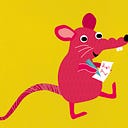Ow! Ow! Ow! And Again Ow!
That’s the sound my brain has been making at the thought of attempting to solve Einstein’s “Famous House Riddle.” The pain is not really my fault. I will blame it on Michele Debczak of Mental Floss, who hooked me with this question: “Can You Solve Einstein’s Famous House Riddle?” My answer should immediately have been this: Are you freaking kidding me? It once took me seven hours, twenty-three minutes, and fourteen seconds to learn how to tie a Windsor knot that did not look like someone’s dog had just — well, you know — just where my shirt collar and neck come together. (I admit that, after four hours, I was considering telling people that someone’s incredible limber, acrobatic, and accurate Weimaraner had dumped on me and, since it somewhat resembled a Windsor tie knot, I just decided to go with it.)
What was my topic again? Oh, right. The house riddle, which Debczak, it turns out, copped from a 2017 issue of Popular Mechanics. So, here it is, and I warn you, look or click away now if you want to avoid this rabbit hole.
There are five houses lined up next to each other along a street. Each house is a different color, and each homeowner is of a different nationality, drinks a different beverage, smokes a different brand of cigar, and owns a different pet. These variables never repeat from house to house. Which homeowner has a pet fish? To solve this, you get the following fifteen clues:
- The Englishman lives in the house with red walls.
- The Swede keeps dogs.
- The Dane drinks tea.
- The house with green walls is just to the left of the house with white walls.
- The owner of the house with green walls drinks coffee.
- The man who smokes Pall Mall keeps birds.
- The owner of the house with yellow walls smokes Dunhills.
- The man in the center house drinks milk.
- The Norwegian lives in the first house.
- The Blend smoker has a neighbor who keeps cats.
- The man who smokes Blue Masters drinks beer.
- The man who keeps horses lives next to the Dunhill smoker.
- The German smokes Prince.
- The Norwegian lives next to the house with blue walls.
- The Blend smoker has a neighbor who drinks water.
Much to my surprise, when I got to the end of this list, I had the answer and my brain didn’t hurt a bit. Thus, I joined the purported two percent of the world’s population that can solve the house riddle. SPOILER ALERT: It’s the German who has the fish, and he smokes Prince cigars, drinks coffee, and lives in the fourth house from the left, which has green walls. I could tell you that I accomplished this feat using logic and a process of elimination, and if you didn’t know me, you might believe this. In fact, I will tell you that. Anything’s possible, and I have been taking extra doses of Prevagen® lately.
While one part of my brain was busy logiminating [applying logic and elimination] the house riddle, another part was wondering about the origin of riddles. While I could have logiminated the answer to this speculation as well, in the interest of preventing the attendant cranium overheating, I turned to Knowitallpedia. I first learn the word “riddle” has Germanic origins, coming from a noun that meant “thing to be guessed, thing to be interpreted.” I next found out that defining what riddles are “precisely is hard and attracted a fair amount of scholarly debate.” Obviously not enough logiminating going on there.
The oldest recorded riddles come from ancient Babylon, which the Babylonians, insidious devils, wrote down without recording the answers: “Who becomes pregnant without conceiving or fat without eating?” or “My knees hasten, my feet do not rest, a shepherd without pity drives me to pasture; what am I?” I could delve into the minutia of riddles here, but ow, ow, ow, and again, ow! Let’s just say that people have told riddles since the dawn of time, mostly to annoy people with stupid questions when they have important, time-sensitive quests to complete. Witness this example from Monty Python and the Holy Grail:
Bridgekeeper: Stop. Who would cross the Bridge of Death must answer me these questions three, ere the other side he see.
Sir Robin: Ask me the questions, bridgekeeper. I’m not afraid.
Bridgekeeper: What…is your name?
Sir Robin: Sir Robin of Camelot.
Bridgekeeper: What…is your quest?
Sir Robin: To seek the Holy Grail?
Bridgekeeper: What…is the capital of Assyria?
[pause]
Sir Robin: I don’t know that.
[he is thrown over the edge into the volcano]
Sir Robin: Auuuuuuuuuugh!
Oh, sorry. That wasn’t really a riddle, was it? But it was annoying and time-consuming. Long story short, riddles have existed and evolved and continued to annoy and enrage people down through the ages until they culminated in the form of one man: The Riddler. This little man in green tormented Batman and Robin endlessly as they fought for truth, justice, and the American way with brain-twisters like this one: “What is the beginning of eternity, the end of time and space, the beginning of every end, and the end of every race?” I won’t tell you the answer to this one because knowing it would just annoy and anger you, which is exactly what the Riddler wants. On the other hand, revealing it might help you avoid ending up with your head in your hands crying ow, ow, ow, and again, ow! Oh, all right. I’ll tell you. The answer is the letter “e”.
Of course, Einstein got it immediately. Pig.
(Published originally on RatBlurt™, June 6, 2022.)
